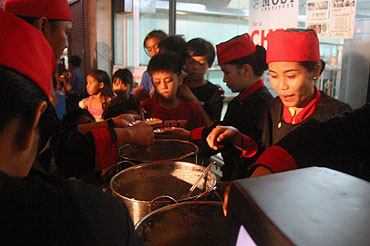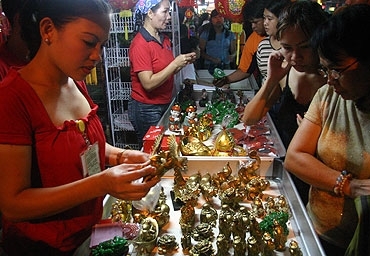Side Bar Story
The Other Night Markets
At first I thought the white car (brand name: Cherry) displayed on the right side of Bangoy street at the Davao Chinatown night market was a prize for patrons. It turned out that it was up for sale.
A few steps away, women handed out flyers. It took a moment for me to notice that the large picture frame was not a painting but a picture of a clubhouse. The women were real estate brokers selling subdivision lots. Now I hadn’t seen that in any of the country�s night markets.
Welcome to Davao city�s first night market!

Held at the Davao Chinatown during the celebration of the Chinese New Year, the affair extended from the corner of Uyanguren and Lizada streets all the way to Uyanguren-Roxas Boulevard.
I found myself on my way to Uyanguren street on the last day of the three day affair. As our jeep was about to cross Uyanguren from Lizada street, I and a photographer friend saw policemen waiting by a sign. Apparently, jeeps and cars were rerouted. Some private vehicles were parked along Lizada. So, we quickly got off.
Vendors selling ukay-ukay blankets, towels and tablecloths immediately greeted us. I found a nice piece of tablecloth but the vendor would not let me haggle, so, we moved on.
I was disappointed at first because the street wasn’t very full. After the blankets, there were several rows of bootleg DVDs.
Past NCCC, my spirits lifted. It was then that I saw across Banggoy Street with its cars and real estate agents. This block was brightly lit by fluorescent and neon lights from rows and rows of Chinese-owned stores.
But aside from the car and the real estate brochures, the next two blocks featured the usual ukay-ukay shirts, pants, jackets, bags, etc., including used plush toys, the tiny ones selling at 20 pesos each while the big ones could go all the way up to 800 pesos each item.
“Cagayan,” my photographer friend said after a few more steps, comparing the Davao night market with those in Cagayan de Oro. I had to admit I recognized the Cagayan feel to it.
Another store sold an assortment of items at five pesos each. The cheap surplus goods didn’t bother me but the vendor who kept blaring at the microphone “Tag-singko, tag-singko, tag-singko na lang. Tag-singko, tag-singko, tag-singko na lang” (Five pesos each, five pesos each, just five pesos each. Five pesos each, five pesos each, just five pesos each), was irksome. His chant could play in your head for days on end. But to his credit, young girls came flocking the store.
I found rubber slippers, the ones that had a black rubber sole reminding me of old tires. They had woven synthetic or cloth straps. Some of them were actually finely crafted and well worth the 100-150 peso asking price. But I have small feet and most of the sizes were geared for men. I spotted the size for toddlers but when I looked underneath, I found the sole too smooth, which could be very slippery and dangerous for kids just learning how to walk.
Most vendors I talked to had regular stalls on Lizada street. They said sales were good because most of them stayed until past midnight in the last two nights at the night market. But another vendor said he was just earning as much as any other Sunday night at Rizal Park.
But where were the Chinoys at the Davao Chinatown�s night market? A Chinese owned department store displayed golden figurines, popular among feng shui enthusiasts and those who just wanted to keep a few pieces of good luck charms.
When we got there all the golden oxen were sold. They went fast, according to the sales girl. After all, the year 2009 was the year of the ox. What remained were frogs � those that had a coin in their mouth � and the buddhas of different sizes and poses; and the less popular but more affordable lucky coins and lucky gold bars.

Some vendors were selling the version of tikoys commonly found in department stores — uncooked and placed in a bright red box — at 125 to 200 pesos each. Tikoy comes from the Chinese word ‘ting ke’, which literally means ‘sweet cake.’ Tikoy has always been considered the star of the Chinese New Year feast. Sliced thinly and cooked the right way, these globs could be heavenly.
Pre-cut globs of about two inches in diameter were also available. A pack of four cost 50 pesos.
Tikoys are popular even among the non-Chinese.
The usual street food — kikiam, kwek-kwek –and bakeries mounted on tricycles selling peanuts and barbecues were there.
Feeling hungry, we chose a stall with a table and whose pork barbecues selling at five pesos each stick and looked most appetizing. But it was so appetizing that, when our turn came, they had nothing left to sell. So we went to the next stand, where each stick cost ten pesos. They ran out of rice so we had to go back to the store where the barbecues ran out.
After dinner, I went looking for more Chinese merry makers and Chinese vendors at Davao Chinatown�s first night market.
Some women dressed in traditional Chinese garb standing outside a culinary school were probably students or teachers but they were not Chinese at all. At the very end of Uyanguren street, the organizers put up a huge screen, where a few people were viewing an interesting documentary on the Chinese contribution to civilization. The quality of the video was very good. The picture, clear and the sound, crisp but the narrator’s droning voice was boring. After a few minutes listening to a discussion on beautiful Chinese gardens, I decided that I had had enough.
It was not a comfortable film to watch. If you were far from the screen, you would have to contend with the banderitas that blocked your view. If you were too near, you had to crane your neck to get a view of the screen placed very high above the arch. No seats were provided. But a few people stayed on. I had to admire the persistence and patience of those who finished the film standing up for two hours.
It was then that I saw two Chinese vendors: a woman who spoke Tagalog after a fashion. She didn�t seem to understand Cebuano. She was selling shirts and blouses, mostly factory overruns. She said she did not have any other store. After the Chinese New Year, she would be left with no money.
Another Chinese entrepreneur, a man this time, was selling bikini swimsuits. A lot of us were looking but nobody was keen on buying.
On our way back, we found the local culinary school nearby deluged with kids. It was giving away three different kinds of porridge. That was what the kids were waiting for. One of the young servers said that they were merely giving back blessings, a nice thought that buoyed me up until I took my ride on my way back home. (CJ Kuizon/ davaotoday.com)
chinese new year, night market, Trade









